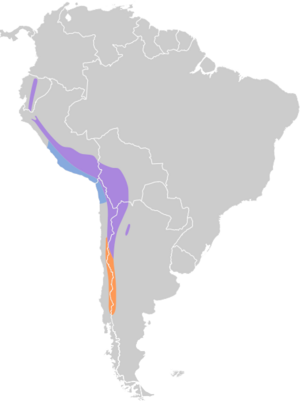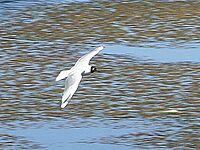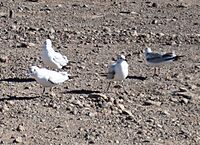Andean gull facts for kids
Quick facts for kids Andean gull |
|
|---|---|
 |
|
| Breeding plumage, Peru | |
| Conservation status | |
| Scientific classification | |
| Genus: |
Chroicocephalus
|
| Species: |
serranus
|
 |
|
| Synonyms | |
|
Larus serranus |
|
The Andean gull (Chroicocephalus serranus) is a type of gull found in the high mountains of South America. It lives in countries like Argentina, Bolivia, Chile, Colombia, Ecuador, and Peru. This bird is part of the Laridae family, which includes gulls, terns, and skimmers.
Contents
About the Andean Gull's Family Tree
Scientists group living things into families. For a long time, the Andean gull was placed in a group called Larus. But new studies using DNA have shown that some gulls needed to be moved.
Now, many bird experts, like the American Ornithological Society, place the Andean gull in a different group called Chroicocephalus. This is because it's more closely related to other gulls in that group. However, some groups, like BirdLife International, still keep it in the Larus group. All experts agree that the Andean gull is a unique species.
What Does the Andean Gull Look Like?
The Andean gull is a medium-sized bird, about 42 to 48 centimeters (17 to 19 inches) long. It weighs around 480 grams (17 ounces). Both male and female gulls look alike.
Breeding Plumage (Summer Look)
When breeding, adult gulls have a shiny black head, like a hood. They have a white crescent shape right behind their eyes. Their body is mostly white, with a gray back. Sometimes, their belly can have a light pink color. Their tail is white.
The top of their wings is mostly gray. The tips of their wings have a cool pattern of white, black, white, and black stripes. The underside of their wings is light gray. It has a blackish outer part, but with big white "mirrors" on the three outermost feathers. Their beak, legs, and feet are dark brown with a reddish tint. Their eyes are brown.
Non-Breeding Plumage (Winter Look)
When not breeding, adult gulls have a white head instead of a black hood. Their legs are blackish.
Young Gulls
It takes two years for a young Andean gull to get its full adult colors. In its first year, it has some dark spots on its head. Its wings have a mix of black and white patterns. There's also a black band near the end of its tail.
Where Do Andean Gulls Live?
Andean gulls live all year round in the Andes mountains. Their home stretches from southwestern Colombia down through Ecuador, Peru, Bolivia, Chile, and Argentina.
Some gulls move to the coast during winter. They go from central Peru down to northern Chile. Scientists are still learning if these gulls come from the high mountains or from the southern parts of their range. Sometimes, a gull might wander far from its usual home, even to the Amazon rainforest in Peru.
Preferred Habitats
During the breeding season, Andean gulls like to live near lakes, bogs, and marshes. They also like fields in high-altitude areas called the puna and páramo zones of the Altiplano. They usually live at elevations from 3,000 to 5,300 meters (9,800 to 17,400 feet). In the southern part of their range, they can be found as low as 1,200 meters (3,900 feet).
In winter, you can often find them at river mouths and sandy beaches along the coast.
How Do Andean Gulls Behave?
What Do They Eat?
In the mountains, Andean gulls eat a variety of things. They look for earthworms, insects, amphibians, and small fish. Sometimes, they even eat the eggs and chicks of other waterbirds. In winter, they might also scavenge for food at ski resorts.
Along the coast, they eat things like leftover fish parts and small sea creatures. They find their food by walking, swimming, or flying.
How Do They Breed?
Andean gulls usually breed in July and August. They sometimes nest alone, but more often they form small groups or colonies. They build their nests along riverbanks or on islands in rivers and lakes.
A female gull usually lays two or three eggs. Sometimes, they lay one or four eggs. Scientists don't know exactly how long the eggs take to hatch or how long it takes for the young birds to be ready to fly. We also don't know much about how the parents care for their chicks.
What Do They Sound Like?
Andean gulls make different sounds. They have "agitated" or "trembling" calls that sound like "yeeer." They also make a rough, "hoarse" sound like "raggh-aggh-keeaagh" and other low, scratchy noises.
Are Andean Gulls in Danger?
The IUCN (International Union for Conservation of Nature) has listed the Andean gull as a species of "Least Concern." This means they are not currently in danger of disappearing. They live in a large area, but we don't know exactly how many there are or if their numbers are changing.
There are no immediate big threats to the Andean gull. However, their breeding areas are often in remote high-altitude lakes. These areas are increasingly being affected by farming and human activities. This could be a problem for the gulls in the future.
Gallery





